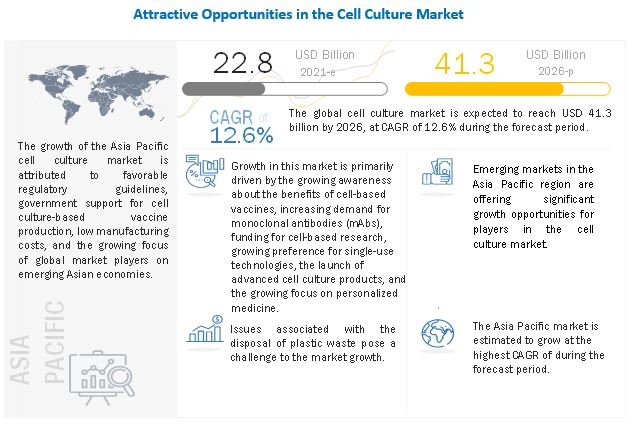According to the new market research report "Cell Culture Market by Product (Consumables (Media, Serum, Reagent, Vessels), Equipment (Bioreactor, Centrifuge, Incubator)), Application (Vaccines, mAbs, Diagnostics, Tissue Engineering), End User (Pharma, Biotech, Hospital) - Global Forecast to 2026", published by MarketsandMarkets™, the global market is projected to reach USD 41.3 billion by 2026 from USD 22.8 billion in 2021, at a CAGR of 12.6 % between 2021 and 2026.
Browse in-depth TOC on "Cell Culture Market"
690 – Tables
43 – Figures
490 – Pages
Download PDF Brochure: https://www.marketsandmarkets.com/pdfdownloadNew.asp?id=559
The growth of this market is majorly driven by the growing awareness about the benefits of cell-based vaccines, increasing demand for monoclonal antibodies (mAbs), funding for cell-based research, growing preference for single-use technologies, the launch of advanced cell culture products, and the growing focus on personalized medicine. On the other hand, the high cost of cell biology research is restraining the growth of this market.
The consumables segment accounted for the largest share of the product segment in the cell culture market in 2020.
Based on product, the market is segmented into equipment and consumables. The cell culture equipment market is further segmented into supporting equipment, bioreactors, and storage equipment. The cell culture consumables market is segmented into sera, media & reagents, vessels, and bioreactor accessories. In 2020, the consumables segment accounted for the largest share of the market. The large share and high growth of the consumables segment can be attributed to the repeated purchase of consumables and an increase in funding for cell-based research.
The biopharmaceutical production segment accounted for the largest share of the application segment in the cell culture market in 2020.
Based on application, the market is categorized into biopharmaceutical production, diagnostics, drug discovery & development, tissue engineering & regenerative medicine, and other applications. The biopharmaceutical production segment is further divided into monoclonal antibody production, vaccine production, and other therapeutic protein production. The tissue engineering & regenerative medicine segment is further divided into cell & gene therapy and other tissue engineering & regenerative medicine applications. The biopharmaceutical production segment is estimated to grow at the highest CAGR of 14.1% during the forecast period. The high growth of this segment is attributed to the commercial expansion of major pharmaceutical and biotechnology companies, the increasing demand for mAbs, and the growing regulatory approvals for the production of cell culture-based vaccines.
Request Sample Pages: https://www.marketsandmarkets.com/requestsampleNew.asp?id=559
The Asia Pacific region is the fastest-growing region of the cell culture market in 2020.
Based on the region, the global market has been segmented into North America, Europe, the Asia Pacific, Latin America, and the Middle East and Africa. The Asia Pacific market is estimated to register the highest CAGR during the forecast period. Government initiatives for research on stem cell therapy, growing geriatric population, the rising prominence of regenerative medicine research, increasing number of researchers in Japan, growth of preclinical/clinical research in China, favorable changes in foreign direct investment (FDI) regulations in the pharmaceutical industry in India, and growth of the pharmaceutical & biopharmaceutical sectors in South Korea are the major factors contributing to the growth of the market in the Asia Pacific.
Key players in the cell culture market include Thermo Fisher Scientific, Inc. (US), Merck KGaA (Germany), Danaher Corporation (US), and Sartorius AG (Germany).
Speak to Analyst: https://www.marketsandmarkets.com/speaktoanalystNew.asp?id=559

No comments:
Post a Comment